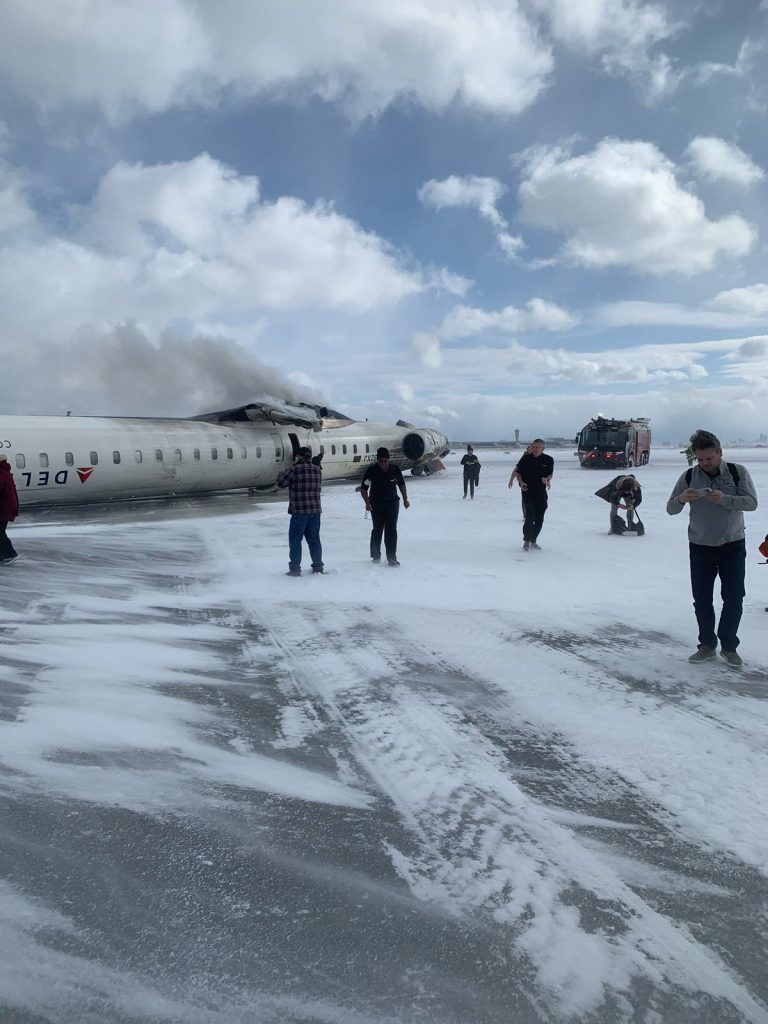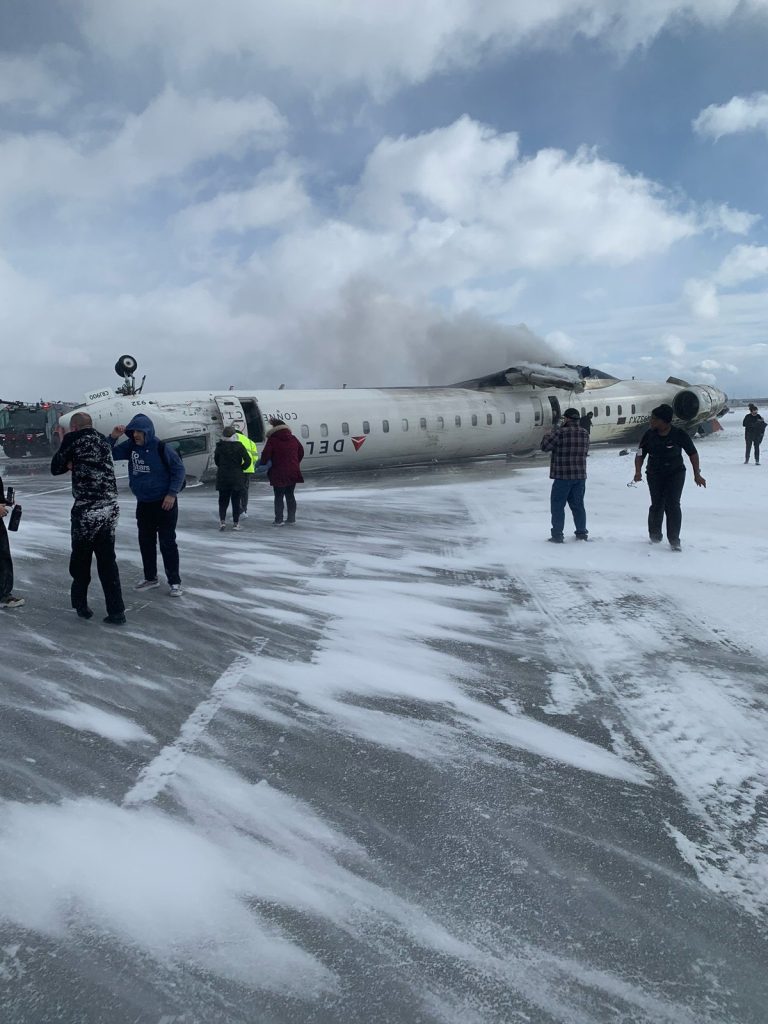Key Takeaways
- On February 17, 2025, Delta Airlines flight 4819 crash-landed at Toronto Pearson Airport, flipped upside down; all 72 survived.
- Eight people sustained injuries; emergency teams quickly evacuated passengers, minimizing harm after the Bombardier CRJ-900LR’s wings tore off.
- Investigations focus on potential causes like mechanical issues, pilot decisions, and runway conditions; results could take months.
On February 17, 2025, a routine regional flight ended in a stunning and terrifying crash landing at Toronto Pearson International Airport 🇨🇦. Delta Airlines flight 4819, originating from Minneapolis-Saint Paul International Airport 🇺🇸 and operated by Endeavor Air, flipped upside down upon landing. The shocking event left airline experts and the aviation industry shaken, as the Bombardier CRJ-900LR came to an abrupt halt on the runway, its wings torn away.
The Day of the Incident

The crash occurred at 2:13 p.m. local time, abruptly halting what was supposed to be an uneventful connection between two major North American airports. At the heart of the tragedy was the Bombardier CRJ-900LR, a 16.6-year-old regional jet known for its reliability on short-to-medium-haul routes. Registered as N932XJ, the aircraft represented the dependable fleet of Endeavor Air, Delta’s regional subsidiary. However, on this day, something went badly wrong.
Eyewitness accounts and viral social media images provided grim accounts of the aftermath. Videos showed the inverted aircraft laying broken on the runway, with rescue crews and emergency vehicles swiftly approaching the site. Social media users, including one passenger on the ill-fated flight, described the surreal horror of being inside an overturned aircraft. Their photos offered the public a rare, chilling look at the experience inside a plane following a violent crash.
The Impact of the Crash
Miraculously, all passengers and crew onboard survived. This survival outcome, despite the aircraft flipping completely and its wings being ripped off from the fuselage, is being hailed as an incredible stroke of fortune. Initial reports confirm that eight individuals suffered injuries during the incident, though the full extent of these injuries remains unclear.
Emergency responders, including fire and rescue teams stationed at Toronto Pearson International Airport 🇨🇦, deserve significant credit for the swift and efficient evacuation. Videos captured passengers being guided safely away from the wreckage, highlighting the critical role that well-coordinated emergency protocols played in minimizing harm.
The Immediate Response and Investigation
An incident of this magnitude leads to immediate investigation, and multiple agencies are now working to uncover the reasons behind this tragic landing. Peel Regional Police issued statements confirming the start of an intensive inquiry, supported by aviation safety authorities tasked with understanding what caused flight 4819’s catastrophic landing.
Investigators will leave no stone unturned, delving into factors such as weather conditions, aircraft mechanics, human error, runway conditions, and air traffic control procedures. It’s vital to understand that uncovering the exact sequence of events takes time. These investigations can take months or longer, requiring detailed analysis of flight data, cockpit voice recordings, and wreckage inspections.
What Could Have Gone Wrong?
Experienced aviation analysts have outlined several potential causes for accidents of this nature:
- Challenging Weather: While no immediate reports indicated adverse conditions, sudden gusts or reduced visibility can create dangerous landing scenarios.
- Mechanical Defects: A detailed review of the 16.6-year-old aircraft’s maintenance history will indicate if any overlooked technical faults contributed to the crash.
- Pilot Decisions: Even minor judgment errors during landing can have catastrophic outcomes.
- Runway State: The condition of the runway, including its surface or the presence of foreign objects, could have affected the landing sequence.
- Communication Failures: Misunderstandings between the flight crew and air traffic control can lead to missteps during landing.
While these remain speculative causes for now, they highlight the complexities aviation experts face in piecing together incidents like this.
The Fallout for Toronto Pearson International Airport Operations
Toronto Pearson International Airport 🚨, serving as one of North America’s busiest hubs, experienced fallout almost immediately after the crash. Major disruptions to regular flight schedules occurred, with numerous flights likely delayed, grounded, or diverted to alternative airports. Airport management swiftly issued advisories to passengers, urging them to avoid restricted areas to allow ongoing emergency responses and investigations. The incident’s operational impact further underscores the broader consequences such events have on the aviation ecosystem.
Delta and Bombardier: Responses Awaited
As both the operator and the aircraft manufacturer, Delta Air Lines and Bombardier are sure to play integral roles in investigating this tragic event. While official statements remain pending from both parties, they are expected to fully cooperate with aviation safety boards to determine how an aircraft with a proven safety record ended up overturned on a major international runway.
Historically, the Bombardier CRJ-900LR has earned a reputation as a reliable, safe option for high-demand regional routes. This crash is anticipated to trigger an in-depth review of Bombardier aircraft operational procedures to ensure no additional risks exist within its fleet. Additionally, Delta will be closely scrutinized in industry conversations about safety practices and oversight.
The Uncommon Nature of Such Events
Commercial airline crashes, while they dominate media headlines, remain incredibly rare in today’s era of advanced technology and rigorous safety standards. High-profile events like this highlight the fragility of even the most reliable systems but also underline the effectiveness of the broader safety framework that allows survival for all passengers and crew.
While aviation safety investigators will focus on flight 4819, the broader public and industry must remember that such crashes are the exception rather than the rule. The remarkable survival of every individual onboard Delta Flight 4819 demonstrates the effectiveness of stringent safety measures adopted across the aviation sector.
Support and Compensation for Passengers
Following an airline accident, airlines typically bear responsibility for ensuring the welfare of passengers and crew. This includes wide-ranging support services that cater to both physical and emotional needs. While specific details about Delta’s current measures are unavailable, the following actions are expected based on past precedents:
- Medical treatment for the injured
- Temporary housing for affected travelers
- Alternative travel plans for stranded passengers
- Psychological counseling for those in need
- Compensation for lost or damaged items
Airlines are legally bound and ethically committed to addressing the hardship faced by survivors, and Delta will likely follow through with similar steps shortly.
Lessons and a Look Ahead
While today we focus on the crash at Toronto Pearson International Airport 🇨🇦 and the tragedy of flight 4819, this incident will likely influence global aviation in the future. Investigators may issue recommendations or call for improvements in areas such as:
- Aircraft maintenance protocols
- Pilots’ training procedures under extreme conditions
- New safety mechanisms, such as improved aircraft stability in emergencies
- Enhanced runway safety checks and communication tools
Ongoing recovery and review efforts will determine how this event informs future decision-making. Behind every tragic crash, there are lessons that reshape aviation to prevent a repetition of the past.
Final Thoughts: Road to Accountability
While Delta Airlines flight 4819’s crash landing involved immeasurable trauma, the fact that every passenger and crew member lived through the ordeal stands as a beacon of resilience. It exemplifies the extraordinary progress of modern aviation safety technologies, emergency response teams, and procedures designed to protect human lives in unprecedented circumstances.
As we await formal investigations into the Bombardier CRJ-900LR crash, the aviation community and public will continue closely following updates. For comprehensive updates about aviation and incident investigations, official sources like the Transportation Safety Board of Canada remain reliable and timely.
Regrettably, incidents like that of Delta flight 4819 create fear but also push the aviation world closer to perfection. For now, the priority is on supporting survivors, analyzing causes, and employing newfound knowledge to prevent future catastrophes. As reported by VisaVerge.com and other outlets, such crises demand responsibility from airlines, airports, and manufacturers alike. The lessons learned from this tumultuous day at Toronto Pearson International Airport 🇨🇦 will, no doubt, improve aviation safety for all.
Learn Today
Bombardier CRJ-900LR → A regional jet designed by Bombardier, known for reliability on short-to-medium-haul routes, accommodating around 90 passengers.
Fuselage → The central body of an aircraft where passengers, crew, and cargo are carried; connects wings and tail assembly.
Aviation Safety Boards → Organizations responsible for investigating aircraft incidents to improve safety and provide recommendations to prevent future accidents.
Runway Conditions → The state of an airport’s landing and take-off surface, concerning its maintenance, cleanliness, and ability to support aircraft operations.
Emergency Response Protocols → Pre-established procedures guiding airports and crews during crises to ensure quick, efficient, and safe handling of emergencies.
This Article in a Nutshell
A terrifying crash landing of Delta Flight 4819 at Toronto Pearson 🇨🇦 on February 17, 2025, left aviation experts stunned. Miraculously, all onboard survived despite the plane flipping upside down. Investigations now aim to uncover causes: mechanical, human error, or weather. This rare event underscores both aviation’s risks and remarkable safety advancements.
— By VisaVerge.com
Read more:
• Toronto Population Growth Surpasses Major U.S. Cities
• Indian Chess Players Granted Toronto Visas for International Tourney
• Toronto Tops Worst Commute Times in North America for Traffic Congestion
• Freeland Links Immigration to Housing Supply in Plan to Cut Building Costs
• Trump Says He’s Serious About Making Canada the 51st State
















